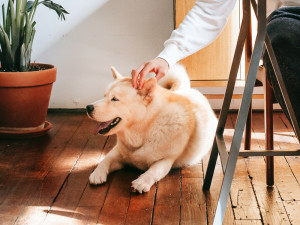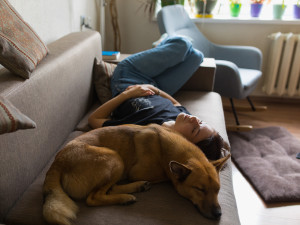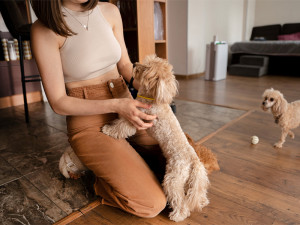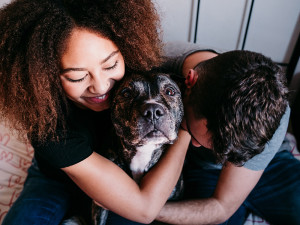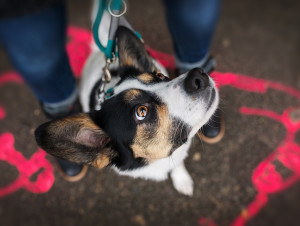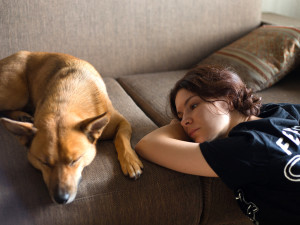Why Do Dogs Like Belly Rubs? The Real Reasons Explained
If one hand isn’t petting a fuzzy dog belly, what are you doing?
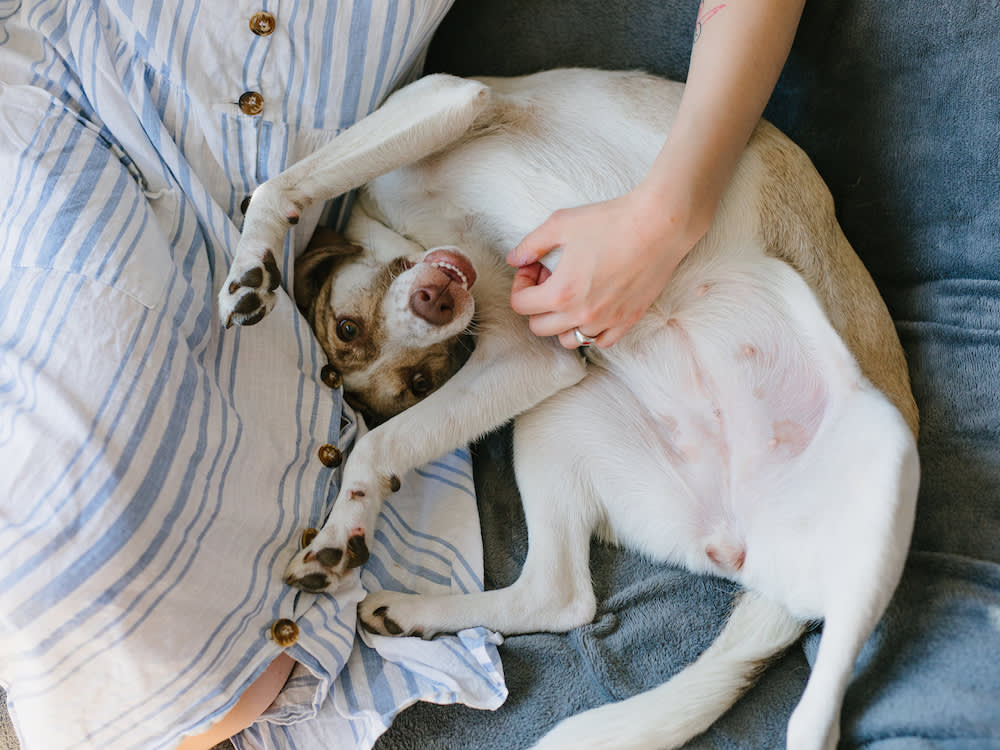
Share Article
In This Article:
Why Your Dog Loves Belly Rubs (And What It Means) Do All Dogs Like Belly Rubs? Can Belly Rubs Be Beneficial for Strengthening the Human-Dog Bond?
People who watch a dog relishing the hedonistic experience of getting a belly rub without their heart melting at least a little are people you don’t need in your life. OK, that’s a bit unfair because such people may have a perfectly good reason for not reacting like a normal person to the sight of a belly rub. It’s hard to say what those reasons might be, but we just have to trust in their existence.
Anyway, luckily this unresponsiveness is rare enough that we don’t need to give it much thought. People generally love watching dogs get belly rubs because the dogs are so clearly loving it. They get a goofy, relaxed look on their face the tongue sometimes lolls about, and they settle in with the deepest trust imaginable. (Who knew they could be any cuter?)

Why your dog loves belly rubs (and what it means)
The average dog loves a belly rub, though that same dog probably doesn’t like being called “average.” There are many reasons why dogs like belly rubs so much — and that’s lucky for us, because who doesn’t like bonding with our dog with a belly rub?
Why do dogs like belly rubs?
Belly rubs feel good, in part because of all the nerve endings in this sensitive area of the body. Mammals, including dogs, have a sensitive type of neuron that responds to stimulation of their hair follicles, so petting and stroking feel good. The soft hairs on the belly may be especially prone to stimulating the neurons that lead to this pleasurable feeling.
It helps them relax.
Belly rubs can lower cortisol levels in your dog (and you!) which means that belly rubs can relieve stress and lead to higher levels of relaxation. That’s an amazingly powerful benefit for a simple belly rub.
It shows trust and builds a bond.
Rubbing your dog’s belly, like other forms of petting, releases endorphins that make your dog feel good and enhances their mood. These chemicals can even help relieve pain. One of the chemicals released is oxytocin, a powerful substance that impacts bonding in many mammals including humans and dogs.
This hormone also enhances love and connection between human mothers and their babies, and even shows up in romantic love. That’s right, belly rubs allow your dog better living through chemistry!
It feels great to them.
Dogs can’t easily reach their belly, so belly rubs offer them a pleasant feeling they can’t achieve on their own. Belly rubs stimulate circulation, which feels good to dogs. The extra blood flow to the area being rubbed helps dogs feel better. That can be especially true if a dog has gas or an upset stomach because the extra blood flow can offer relief.
It offers them attention and affection.
Any physical contact that feels good to your dog can be a way to give them attention and express your affection at the same time. A happy dog on the receiving end of a belly rub is a dog who is feeling loved, safe, and valued. Positive attention, especially of the kind that is soothing and fills them with positive feelings, is a great way to share the love.
Do all dogs like belly rubs?
Not all dogs like belly rubs. Perhaps it doesn’t feel good, or maybe they feel too vulnerable to expose their underside. Some may be ticklish, and others may have had a negative experience with a belly rub.
Whatever the reason may be, don’t try to rub the belly of a dog who doesn’t want you to, whether it’s your own dog or someone else’s. Start slowly and gently, and if the dog seems uncomfortable in any way, immediately stop.
Are there any alternatives for dogs who don’t like belly rubs?
If your dog prefers to have their chest, their ears, or their butt be the focus of your attention, then pet them there. If they shy away from any physical contact, respect their feelings and interact in ways they enjoy.
It’s simple — if your dog doesn’t like belly rubs, pet them how they like to be pet, and if they don’t like physical contact of any kind, respect that and don’t force them, just as it’s wise not to force hugs.
How to give your dog a great belly rub
As individuals, dogs like different types of physical contact, and those variations in preferences apply to belly rubs. The best way to give your dog a belly rub they will enjoy is to pay attention to how they respond to what you are doing and to adjust accordingly.
Try either long strokes, circular motions with and without using your nails, or gentle pats for a few seconds. Watch your dog’s response to each of these belly rub styles before taking a little break to see if they walk away or seem to invite more by pawing at you, staying in place or open their posture even wider. If they relax into your motions, sigh, or ask for more when you stop, chances are you are doing something they like.
Can belly rubs be beneficial for strengthening the human-dog bond?
Any activity enjoyed together and by mutual consent can be good for the relationship. Petting our dogs, including belly rubs, offers an opportunity for a positive feedback loop of oxytocin and bonding. The more we connect, the more we both produce oxytocin, and the oxytocin makes us feel closer to each other.
Petting is practically magical with its power to make us feel closer to each other, to lower our blood pressure, and to release stress. It’s not an exaggeration to say that belly rubs (like other petting of our dogs) is good for our relationship and enhances our quality of life as well as theirs.
Bottom line
Many dogs love belly rubs, and that’s great for people, because many of us love to give them belly rubs. Dogs look mind-bendingly endearing when they roll over on their backs, mouths flopping around, tails wagging, and generally enjoying themselves.
Belly rubs can be a great way to bond with your dog and show them affection. And if they like belly rubs, who are we to deprive them of this pleasure in life?
References
Marshall-Pescini, Sarah, et al. “The Role of Oxytocin in the Dog–Owner Relationship.” Animals, vol. 9, no. 10, 12 Oct. 2019, p. 792, www.ncbi.nlm.nih.gov/pmc/articles/PMC6826447/, https://doi.org/10.3390/ani9100792opens in new tab.

Karen B. London, PhD, CAAB, CPDT-KA
Karen B. London is a certified applied animal behaviorist (CAAB) and certified professional dog trainer (CPDT) who specializes in working with dogs with serious behavioral issues, including aggression. She has written for a variety of magazines including The Bark, Clean Run, and the APDT Chronicle of the Dog, and has published in scientific journals including Behavioral Ecology and Sociobiology, Ethology, Ecology, and Evolution, the Journal of Insect Behavior, and Insectes Sociaux. She is the author of seven books about dog training and canine behavior, including the forthcoming My Dog's Mystery Adventure: And Other Stories From a Canine Behaviorist and Dog Trainer.
Related articles
![Woman wearing a black t-shirt and jeans laying on the couch with her dog taking a nap]()
What Are the Effects of Sleeping With Your Dog in Bed?
There are pros and cons of sleeping with your dog — for both of you.
![Australian shephard and Corgi mix play fighting outside]()
How to Recognize the Signs of Dog Aggression
A PSA to pay better attention to our best friends’ body language.
![A woman sitting on a floor playing with her dogs.]()
How to Know if Your Dog Has Imprinted on You
If they’re following you around like your shadow, there’s a reason for that.
![Couple hugs their merle Boxer]()
How to Improve Your Relationship with Your Dog
Animal behaviorist Dr. Karen B. London on how to strengthen your pet-parent bond.
![Dog on leash sitting on a colorful street and looking attentive at their pet parent]()
How to Get Your Dog to Pay Attention to You
Here are some simple steps to pry your pup away from that one spot in the yard they’re obsessed with.
Does My Dog Love Me? How to Interpret Canine Bonding Behavior
What to do when you don’t feel the close bond you want.


